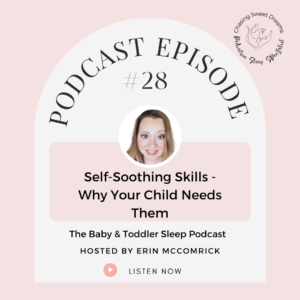
Self-Soothing Skills – Why Your Child Needs Them
Your baby needs self-soothing skills to sleep through the night. This is the ability to relax so she can drift into sleep. She’ll need these skills again when she surfaces from a sleep cycle in the night, as all humans do.
When you do “sleep training” aka “sleep teaching” you are removing your baby’s favorite sleep crutch so that she can develop self-soothing skills.
To ensure you and I are on the same page in this conversation, let’s talk about what “sleeping through the night” really means.
Listen to the podcast
Sleeping Through the Night
In my world sleeping through the night means 11-12 hours overnight without feeding. Your child’s age and feeding source and habits will both influence when that can occur. This can vary from 5 months to 10 months depending on these factors.
If you’re like many of the parents I’ve worked with, you’ve probably tried one of the following to get longer stretches of sleep at night:
-
- Increasing your child’s calories during the day
- Adding cereal into the mix near bedtime
- Playing white noise
- Putting your shirt in her crib with her
- Changing up her bedtime routine
- Giving a bath before bed
- Bringing her into bed with you
But…. *sigh*, while some of these things may provide temporary comfort, your little one likely still woke up during the night.
Your child needs “Self Soothing Skills” to be able to sleep through the night.
Without this important skill, it is unlikely your child will be able to sleep through the night.
This means that your child needs to be able to transition from calm but awake, into sleep.
And when I say calm but awake, I don’t mean drowsy. If she’s drowsy, then something has helped her to relax.
She needs self-soothing skills to be able to relax so she can drift off into sleep.
If she can learn to do this at bedtime, when the drive to sleep is the greatest, then she will then be able to self-settle back into sleep in the middle of the night when she surfaces from sleep.
All humans surface from sleep in the night. You may roll over, check the clock, nudge your husband in the ribs to stop him from snoring, and then relax back down into sleep. Our baby or toddler needs to have the self-soothing skills to do the same thing as you.
The One Thing Your Baby Needs to Sleep Through the Night can manifest in different ways:
-
- Sleeping in a favorite position
- Many kids prefer to sleep on their stomach
- We always put kids down on their backs, when they can roll they are safe to sleep on their stomachs
- Rubbing a cheek or back of the head into the crib mattress
- Sucking a thumb or finger
- Moaning or groaning
- Blowing raspberries
- Rubbing a piece of material between her thumb and fingers or on her face
- Tactile soothing is extremely common
The challenge with self-soothing skills is that they often won’t develop until you take away the sleep crutch she currently uses to help her fall asleep.
Scary thought, right?
A sleep crutch is something external that your child uses to help her relax and can be broken down into 3 categories:
-
- Sucking
- Being fed to sleep or to drowsy
- Using a pacifier
- Motion
- Being rocked
- The motion of a car or stroller
- Touch
- Being held
- Sleeping beside or on someone
- Sucking
The next question you might be asking is how do you take away that sleep crutch so that self-soothing skills can develop?
Unfortunately, there is no quick fix for this and ultimately what we’re talking about is doing some “sleep training.”
Sleep Training
I dislike this term immensely as it sounds so cruel and much prefer the term, sleep teaching. That’s what we are doing, teaching your child to fall asleep on her own.
Sleep training “sleep teaching” is removing the sleep crutch so that your child can develop some self-soothing skills.
However, there is so MUCH more to sleep training. Teaching your baby to sleep involves her entire day and night which are so intrinsically linked. Sleep teaching is learning what is age-appropriate for your child in terms of sleep and feeds. Setting her up for success with age-appropriate expectations, and schedules, and being able to be consistent about the message you are delivering.
And it does not mean closing the door and not going back in. Your child deserves to be acknowledged and heard.
If you’re thinking the way your baby falls to sleep or has to fall back to sleep is becoming unsustainable, send me an email or set up a discovery call! I am here for you!
Sending sleepy vibes and sweet dreams your way!
Erin McCormick
Your Pediatric Sleep Consultant


